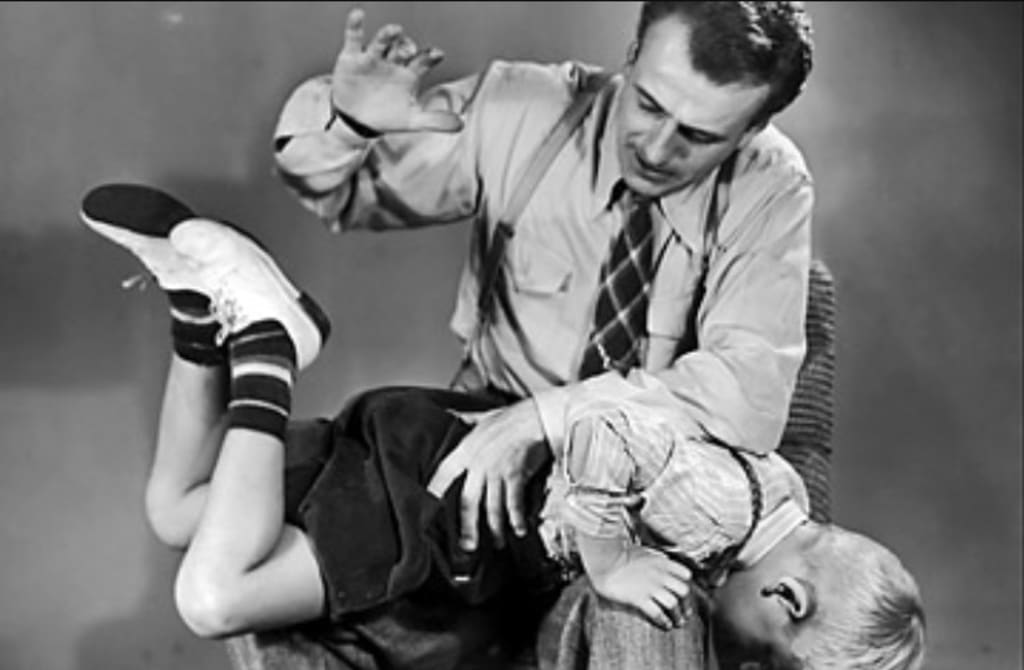
Many Americans believe that physical punishment is effective and harmless, despite what research shows. This form of discipline can mentally damage a child in a number of ways. Physical punishment used to get rid of an unwanted behavior can negatively affect three basic steps in learning, classical conditioning, operant conditioning, and cognition.
Most psychologist today agree that classical conditioning is one of the basic forms of learning, by which all organisms adapt to environments (Myers D. G.). Ivan Pavlov conducted an experiment with dogs and stimulating salivation. It is known that dogs and most other animals salivate when eating food. However, Pavlov soon found that the sight and smell of food, the dish, and even the person that delivers food stimulated salivation. To explore this more, Pavlov isolated the dog, to eliminate any other influences and attached a device to measure saliva. Next, they would slide the food dish to the dog followed by a pitch from a tuning fork. They wanted to see if pairing a neutral stimuli that wasn't initially associated with food could then become paired and link up with an unconditioned response (naturally salivating when food is present). He proved this experiment to be true. He could eventually trigger salivation just by the tone of the pitch fork. The salivation response to the tone has become a learned response. It is conditional upon the association with food. Generalization also occurs with conditioned stimuli. For example, if they used a belly rub instead of a tone, a belly scratch may trigger salivation. Children told to stay away from moving cars also stay away from trucks and motorcycles. Or when a angry looking face is presented on a screen in front of abused children, their brain waves are dramatically stronger and long lasting (Pollak et al., 1998). Discrimination was also shown with Pavlov's dogs. They are able to distinguish condition stimuli. For example, when confronted by a police dog, one may experience fear and anxiety regardless if they are unlawful, whereas if they were confronted by a puppy, fear or anxiety would most likely not be present (Meyers D. G.). Gustavo Carlo, a professor and director for family policy says, “If we think of a child's development as a jigsaw puzzle where many things are affecting our kids, this is one of the pieces of the puzzle that increases the chances of negative child outcomes.”(Abassi, W. 2017).
Another basic way of learning is operant conditioning. Operant conditioning is when a behavior is strengthened by a reinforcer, or diminished if followed by a punisher (Myers D. G). With operant conditioning people associate actions with consequences. One survey participant states, “I feel as if being spanked whenever I did something bad as a kid has given me anxiety whenever I mess up now.” Operant conditioning is the biggest factor that affects a child's behavior. B.F. Skinner(1904-1990) was a psychologist who conducted studies on operant conditioning and what plays into it. Skinner experimented with hungry rats in a box. These rats would be rewarded with food once they performed the task of pushing down on a bar. Skinner would shape the rats into doing this action. Food was giving to the rats when they got close to the bar. Once they figured out that they were rewarded by being near the bar, the reward was taken away. The food may be rewarded back if the rat touches the bar and so on, until the desired behavior is completed. Every day, we shape and reinforce behaviors. An example from Psychology: Tenth Edition in Modules 2014:
Billy: Could you tie my shoes?
Father: (continues reading paper)
Billy: Dad, I need my shoes tied.
Father: In a minute.
Billy: DAAAAAD! TIE MY SHOES.
Father: (ties shoes)
Billy’s behavior was reinforced, because he ultimately got what he desired. The father's response is also reinforced, because he got Billy to stop whining. Negative reinforcement will strengthen a response, because his father wanted to stop the whining. His father's response was negative. Another example, taking excedrin to relieve a headache or hitting snooze: these acts provide negative reinforcement and increase the chances of this behavior repeating. However, negative reinforcement can coincide with positive reinforcement. A student decides to hang out with friends instead of studying for an exam and fails. The students then studies before the next exam and is positively rewarded with a good grade and is less likely to perform the last behavior. As stated before, reinforcement increases a certain behavior, while a punishment will do the opposite, like a child touching a hot stove learns to not touch it again. Many psychologist note four major drawbacks of physical punishment(Gershoff, 2002; Marshal, 2002).
- Punished behavior is suppressed, not forgotten. This temporary state may (negatively) reinforce parents’ punishing behavior. A child swears, parents spanks, the parent hears no more swearing and feels as if the punishment worked and stopped the behavior.
- Punishment teaches discrimination among situations. Discrimination occurs when someone learns that certain responses, but not others, will be reinforced. Did the punishment actually end the child's swearing? Or did the child just learn that it is not okay to swear in the house?
- Punishment can teach fear. Generalization occurs when a person's response to similar stimuli is reinforced. A child may associate fear not only with a behavior but the person giving punishment.
- Physical punishment may increase aggression by modeling aggression as a way to cope with problems. Studies have shown that spanked children are at risk for aggression, depression, and low self-esteem (Stratus & Gelles, 1980; Stratus et al., 1997).
A parent's quote from my survey greatly supports this. She states, “There are better ways to discipline kids. Spanking them only teaches them that lashing out in anger is how to deal with the problem. I also believe that some kids who are more timid, spanking gives them anxiety issues to the point where they become extremely upset with themselves when they have messed up or done something wrong. Time outs work wonders, especially if there are other kids around having fun. This can sometimes be pure torture to them. I also believe that spanking causes children to distrust their parents. When kids fall and get hurt they want to run to mom or dad for comfort, but when the parent causes pain, it confuses the child. Lastly, spanking can create sneaky and dishonest kids because getting spanked only teaches not to act out at home.”
The cognitive part of learning focused on is observational learning. This is learning by not direct experiences, but by observing behaviors. We learn how to speak by observing and imitating this process is called modeling. Albert Bandura did an experiment with observational learning. Bandura sat in a room filled with toys with a child. The child was initially drawing a picture while Bandura was working on toys. Bandura eventually got up and start abusing the toys and yelling profane words at the toys. After about ten minutes, he left the room and the child was taken into another room filled with toys. The child was told to save all the toys for the other children to play with. But the child still abused the toys in the same way that Bandura did and even used the same profane words (Bandura, A 1977). The theory behind this is if you use physical acts to punish like spanking, the child may see that aggressive tactic as a way to cope, and therefore become more aggressive themselves. Another large factor in imitation and modeling is mirror neurons. Mirror neurons are neurons in the frontal lobe that are believed to fire when one performs a certain action, or when observing another doing a certain action. Bandura’s studies and mirror neuron research prove that we mentally imitate, and the models we learn from can be good or bad. Focusing on the bad or antisocial effect shows us why abusive parents may have aggressive children. Observational learning is powerful in this topic. Most children see physical punishment as a way of power, as well as a way to cope. This mirroring effect on the child may display this behavior and create a “bully.” A study in homes where physical punishment was practiced shows this. Researchers interviewed children ages three to seven from over a 100 different families. The children in these families were more likely to endorse hitting as a way to cope and resolve conflict (Gershoff).
Sandra Graham-Bermann, PhD, and a professor of psychology at the University of Michigan says that most people do not understand the effects of physical punishment. Studies show that spanking, hitting, and any other form of physical punishment have shown to lead to increased aggression, antisocial behavior, anxiety, and more (Smith B 2012). “Physical punishment does not work to get kids to comply, so parents think they have to keep escalating it. That's whats so scary,” says Elizabeth Gershoff, PhD leading researcher of physical punishment at the University of Texas at Austin. The evidence shows that physical punishment is not a useful way of teaching a child behavior. Over thirty countries have banned any type of physical punishment because they have deemed it unnecessary. Physical punishment only works momentarily, to stop the problem behavior, because children are afraid to get hit.
70 percent of Americans believe that is is sometimes necessary and acceptable to spank their children. Obviously, parents use this form of discipline in order to correct a behavior. An article on goodparent.org, one of many sites new parents pay attention to, favors corporal punishment. They provide evidence for physical punishment. The article states that there are two types of parenting, authoritative and permissive. According to the website, “authoritative parents are more controlling, restrictive, less inclined to explain, more punitive, detached, and less warm. To discipline they used fear, little encouragement, and often corporal punishment.” whereas permissive parents are “less controlling, minimally demanding, frequently granting of the child's demands, uninvolved, and benign towards the child's impulses and actions. To discipline they use ridicule, guilt provocation, little power and reasoning, and rarely corporal punishment.” The authoritative parents say that they have more control over their children, their children respect and are friendly, as well as cooperation with other adults, whereas the permissive parents have more struggle with controlling situations and experience more extreme outbursts of rage when the child is not granted demands. When conducting surveys with parents most also agreed that physical punishment is a necessity. Here are a few quotes from parent who partook in the survey:
“Spank them if they need it. No parent wants to do it, but if the punishment fits the crime you may have to.”
“At home some kids need to be punished by their parent, not a beating, just a spank. A spanking gets their attention.”
“Spanking is necessary because it teaches that actions have consequences. That's how I was raised. It is completely different with my little brother. When we were young, my mom didn't use physical punishment on him and you could tell. I really do believe that spanking teaches children that they aren't entitled to everything later on in life.”
In reality, there is not much research out there that supports physical punishment. This was a major problem when finding secondary research for this paper. However, that is evidence itself. Overall, physical punishment may or may not have negative effects on a child development and behavior. Most research shows that it does, however, strictly depend on the child and existing psychological physiology. You will find, especially in older generations, that spanking is almost a must to them, as people experience that as a child they are likely to imitate that same tactic with their kids. But the imitating does not start there. When you swat or spank a child, you are a model to them. Many psychologists and studies have shown that children will use physical aggression as a way to cope. If done right, physical discipline can be totally ruled out. You just have to understand how operant and classical conditioning work really well. With this, it is important to not give into a child's whining. If you do, it will reinforce the negative behavior as shown with Billy and his father earlier in the paper. To stop an unwanted behavior, it is advised to take them away from the reinforcer, as well as reinforcing good behaviors. As stated before, children do learn by observing. If a child observes a good behavior, reinforce it and let them know that behavior is wanted and accepted, and vice versa. This will shape the child's behavior. To end, if a child misbehaves or is deficient, do not yell or swat. Simply explain the misbehavior and give them a timeout. If that does not work, spanking must be only used as a backup when other disciplinary tactics fail, like removing them from reinforcing surroundings. The spank also is combined with a generous amount of reasoning.
Work Cited
Smith, B. L. (n.d). The Case Against Spanking. Retrieved October 17, 2017,
\from http:/www.apa.org/monitor/2012/04/spanking.aspx
Abbasi, W. (2017, September 18). Harmful effects of spanking a toddler can
trigger bad behavior even 10 years later. Retrieved October 13, 207, from
https://www.harmful-effects-spanking-toddler-can-trigger-bad-behavior-eve
n-10-years-later/562203001/
Myers, D. G. (2014). Psychology: Tenth edition in modules. New York, NY:
Pub.
Is It Okay To Spank? (2014, July 02). Retrieved October 20, 2017, from
http://www.parenting.com/article/is-it-okay-to-spank
Evidence Favoring the Use of Disciplinary Spanking. GoodParent.org.(n.d.).
Retrieved October 20. 2017, from
http://goodparent.org/corporal-punishment/research-on-corporal-punishme
nt/evidence-favoring-the-use-of-disciplinary-spanking/
Cuddy, E., & Reeves. R. V. (2016, October 26). Hitting Kids: American
parenting and physical punishment. Retrieved October 20, 2017, from
https:/www.brookings.edu/research/hitting-kids-american-parenting-and-ph
ysical-punishment/
About the Creator
Dain Kern
I am a neuroscience/biology minor and psychology major at Weber State University. I am also an avid outdoorsman and a landscape photographer. Many people are fed false information, I am here to provide truth backed by primary research.






Comments
There are no comments for this story
Be the first to respond and start the conversation.